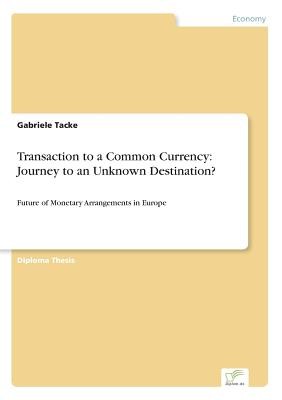
- We will send in 10–14 business days.
- Author: Gabriele Tacke
- Publisher: Diplom.de
- Year: 1999
- Pages: 80
- ISBN-10: 3838613503
- ISBN-13: 9783838613505
- Format: 14.8 x 21 x 0.5 cm, softcover
- Language: English
- SAVE -10% with code: EXTRA
Reviews
Description
Inhaltsangabe: Abstract: "One Market - One Money." On paper the future of European Monetary Integration never looked more promising than now: -The Maastricht Treaty has finally been ratified by all twelve member governments in mid October 1993, even the most sceptical states Denmark and the U.K., so that the aim of European Monetary Union (E.M.U.) rests on a solid legal basis now. -On January 1, 1994 the European Monetary Institute (E.M.I.) began its operations with a goal of intensifying monetary coordination in Europe.} In addition, the E.M.I. will prepare the conceptual groundwork for the activities of the future European Central Bank (E.C.B.). -The " Road to a common Europe" has been opened and monetary policy roadsigns point in the direction of European Monetary Union with a single currency. In reality, the prospects of the achievement of E.M.U. have deteriorated in the course of 1993 and under present conditions the likelihood of a failure of the Maastricht Treaty is quite high. The European currency crises in September 1993 led to realignments within the European Monetary System (E.M.S.) and fluctuation margins were widened to +/- 15 per cent. These events and a breakdown of cooperation between national monetary authorities have raised doubts about the feasibility of the timetable for moving towards full monetary union. This thesis provides an overview of the progress towards a monetary union, including a common currency, in the European Community (E.C.). In addition, it examines whether the approach to monetary union remains viable and if so, the circumstances under which monetary union will eventually happen. Inhaltsverzeichnis: Table of Contents: AcknowledgementsIV AbbreviationsV List of Tables and FiguresVI PART I 1.Introduction1 2.Developments and Purposes to European Honetary Union 4 2.1Definition of a Monetary Union4 2.1.1Background to the current Initiative on European Monetary Union5 2.1.2Why European Monetary Union now?8 2.2Char
EXTRA 10 % discount with code: EXTRA
The promotion ends in 18d.17:13:42
The discount code is valid when purchasing from 10 €. Discounts do not stack.
- Author: Gabriele Tacke
- Publisher: Diplom.de
- Year: 1999
- Pages: 80
- ISBN-10: 3838613503
- ISBN-13: 9783838613505
- Format: 14.8 x 21 x 0.5 cm, softcover
- Language: English English
Inhaltsangabe: Abstract: "One Market - One Money." On paper the future of European Monetary Integration never looked more promising than now: -The Maastricht Treaty has finally been ratified by all twelve member governments in mid October 1993, even the most sceptical states Denmark and the U.K., so that the aim of European Monetary Union (E.M.U.) rests on a solid legal basis now. -On January 1, 1994 the European Monetary Institute (E.M.I.) began its operations with a goal of intensifying monetary coordination in Europe.} In addition, the E.M.I. will prepare the conceptual groundwork for the activities of the future European Central Bank (E.C.B.). -The " Road to a common Europe" has been opened and monetary policy roadsigns point in the direction of European Monetary Union with a single currency. In reality, the prospects of the achievement of E.M.U. have deteriorated in the course of 1993 and under present conditions the likelihood of a failure of the Maastricht Treaty is quite high. The European currency crises in September 1993 led to realignments within the European Monetary System (E.M.S.) and fluctuation margins were widened to +/- 15 per cent. These events and a breakdown of cooperation between national monetary authorities have raised doubts about the feasibility of the timetable for moving towards full monetary union. This thesis provides an overview of the progress towards a monetary union, including a common currency, in the European Community (E.C.). In addition, it examines whether the approach to monetary union remains viable and if so, the circumstances under which monetary union will eventually happen. Inhaltsverzeichnis: Table of Contents: AcknowledgementsIV AbbreviationsV List of Tables and FiguresVI PART I 1.Introduction1 2.Developments and Purposes to European Honetary Union 4 2.1Definition of a Monetary Union4 2.1.1Background to the current Initiative on European Monetary Union5 2.1.2Why European Monetary Union now?8 2.2Char


Reviews